Confucius temples (Kongmiao 孔廟, also called Kongzimiao 孔子廟 or Fuzimiao 夫子廟) are "cultured" or "civilian" temples (wenmiao 文廟), in contrast to "military temples" (wumiao 武廟), where the God of War (Guandi 關帝) is venerated. The person venerated in "civilian" temples is the philosopher Confucius (Kongzi 孔子), the founder of the philosophy Confucianism, and preeminent object of the religion of Confucianism.
The Confucius temple per se is the ancestral temple in Confucius' hometown Qufu 曲阜 (Queli 闕里), Shandong. It was built as early as 478 BCE with a size of three halls. In 153 CE, the Confucius Temple in Qufu was made a national site of religious rituals. Through the ages, the original temple was reconstructed and enlarged. The first attested Confucius temple in an imperial capital was built in 619 in the then-capital Chang'an 長安 (present-day Xi'an 西安, Shaanxi) on the compound of the Directorate of Education (guozijian 國子監).
 |
 |
Left: Arrangement of musicians and administrative personnel during a ceremony in the Confucius Temple of the Directorate of Education (guozijian 國子監). From Lan 1845: 403. Right: Arrangement of food and beverage containers for a sacrificial ceremony in a Confucius Temple. The position is marked by encircled word. Images of each container type are inserted. Candles and incense sticks are not illustrated. Following Lan 1845: 832, 413ff. |
|
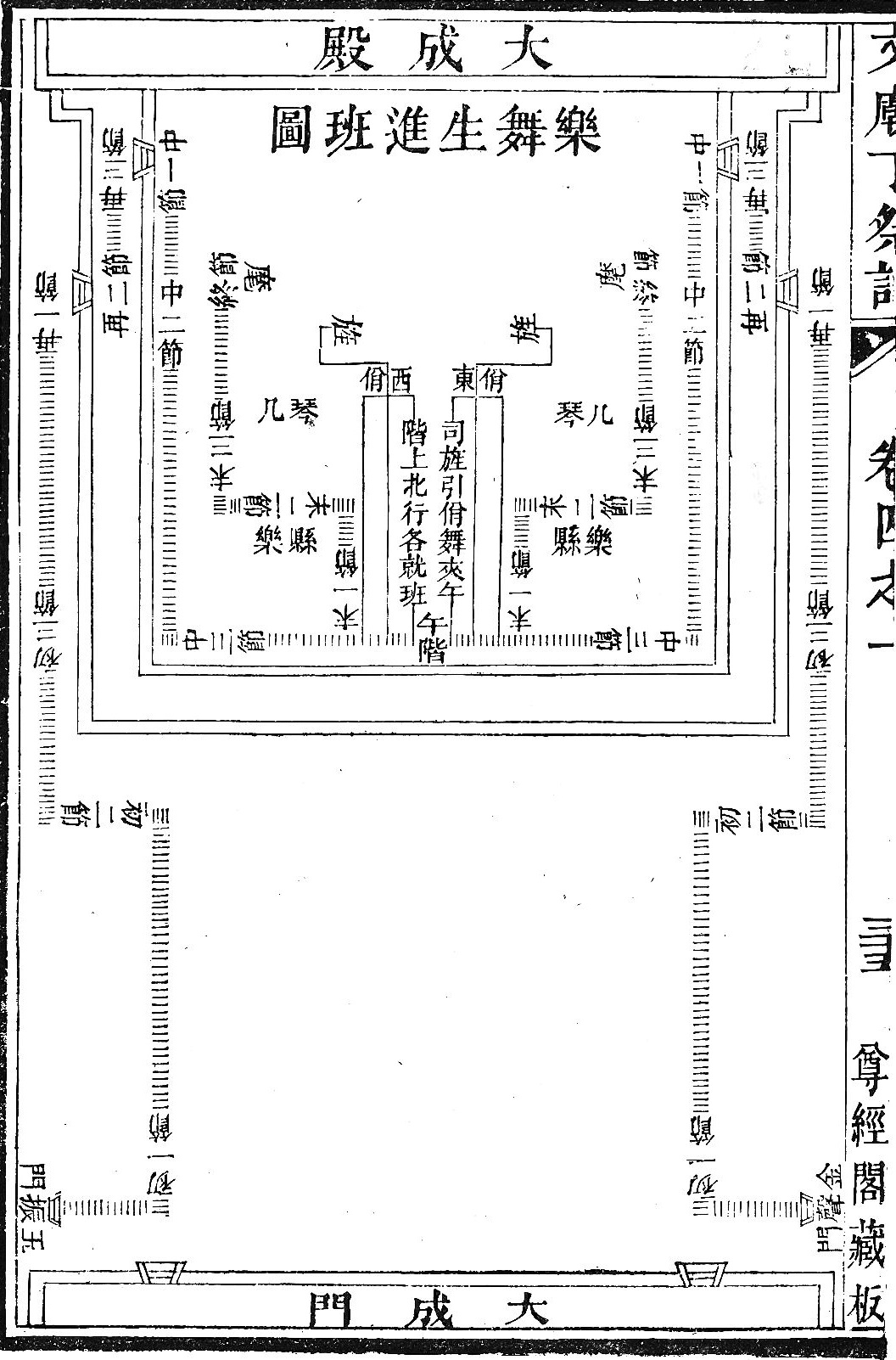 |
 |
Left: Arrangement of musicians in the central Hall of Completion (Dachengdian 大成殿) of the Confucius Temple in Qufu. From Lan 1845: 856. Right: Movements of dancers to the words of a hymn. From Chen 1504: 111. |
|
 |
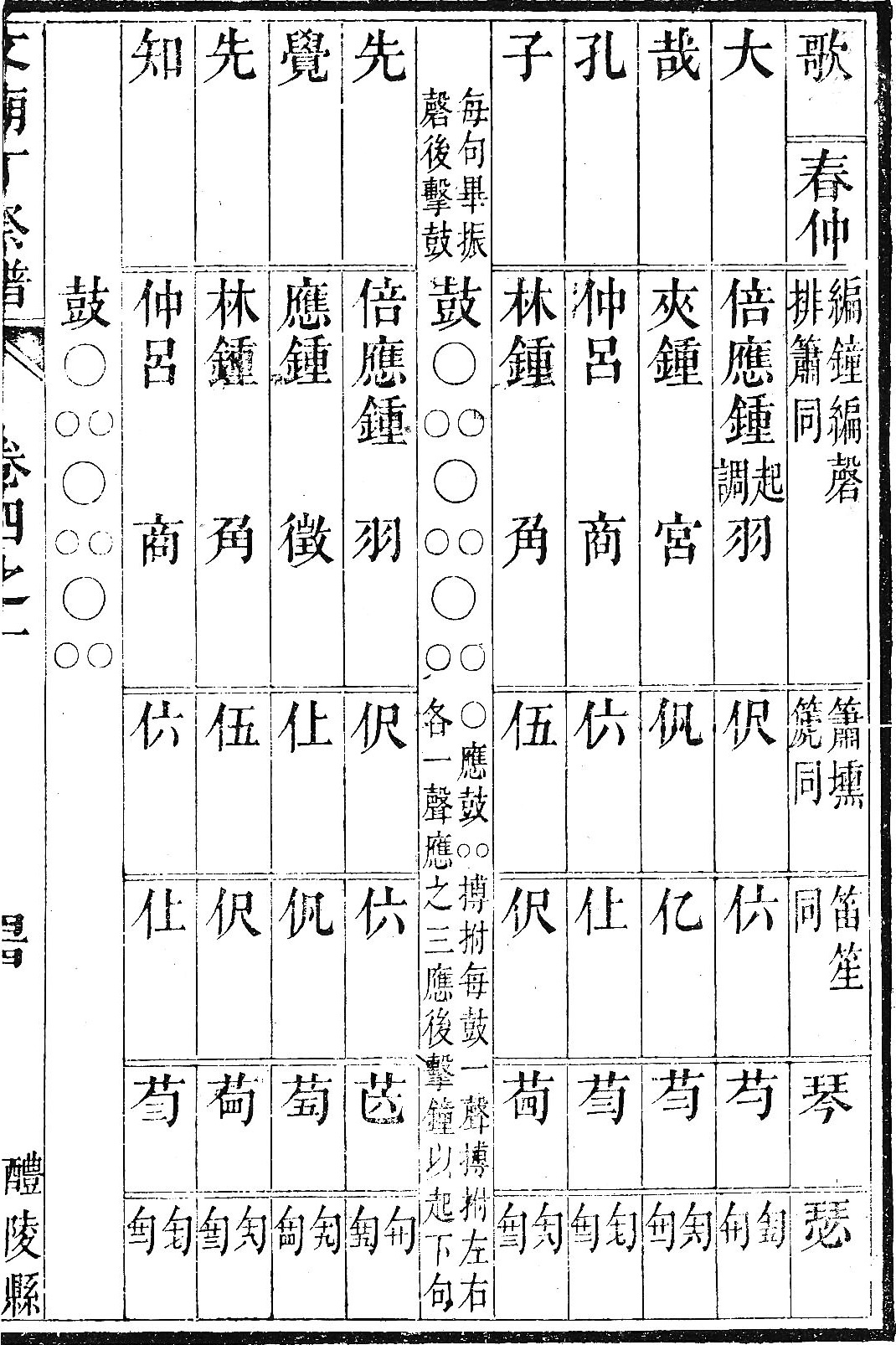 |
Left: Drawing of a sound stone (qing 磬) as used during sacrificial ceremonies in Confucius temples. Right: Score of a hymn sung during the mid-spring ceremonies. From top to bottom: Text (大哉孔子,先覺先知); tones of bells, sound stones, and panflutes; ocarinas and flutes; whistles and mouth organs; small zithers; large zithers. Drums are beating after each four-syllable verse. From Lan 1845: 585, 873. |
|
The first emperor delivering sacrifices to Confucius (ci Kong 祠孔, ji Kong 祭孔) was Emperor Gaozu 漢高祖 (r. 206-195 BCE), founder of the Former Han dynasty 前漢 (206 BCE-8 CE), during an inspection tour to Qufu. In 629, Fang Xuanling 房玄齡 (579-648) and Zhu Zishe 朱子奢 (d. 641) suggested to bestow on Confucius the title of "Primordial Saint" (Xiansheng 先聖). A year later, an imperial edict ordered to build a Confucius temple in every prefecture and district. This became common thereafter, so virtually every town throught the country had a Confucius temple. There is report that the Northern Qi dynasty 北齊 (550-577) issued a decree to found shrines for Confucius and his disciple Yan Yuan 顏淵 (Yanmiao 顏廟) in every local school (xuefang 學坊) (Deng 1998, Wang 1988). Confucius shrines are also found in academies (shuyuan 書院), as there was a common saying that no school should miss a shrine for the Primordial Teacher. In the Song period 宋 (960-1279), the group of teachers venerated in schools and academies was enlarged by the seven grand Neo-Confucian masters (qi xiansheng 七先生), among them Shao Yong 邵雍 (1011-1077), Zhou Dunyi 周敦頤 (1017-1073), and the brothers Cheng Hao 程顥 (1032–1085) and Cheng Yi 程頤 (1033-1107).
A Confucius temple is usually located side by side with a prefectural school (fuxue 府學), and in the capital city, next door to the Directorate of Education and the National University (taixue 太學).
Examinees of the metropolitan examination used to pray before participating in the evaluation process. The names of successful graduates were incised into tone slabs erected on the compound of the Confucius Temple in Beijing. The Confucius Temple in Nanjing 南京, Jiangsu, is called Fuzimiao. The city of Tianjin 天津 has a Confucius Temple (Wenmiao) from the Ming period 明 (1368-1644), and in Quanzhou 泉州, Fujian, a Confucius temple from the Northern Song period 北宋 (960-1126) is preserved (in the shape of a Southern-Song period reconstruction). The largest Confucius temple on district level is that in Zizhong 資中, Sichuan. The Confucius Temple of Suzhou 蘇州, Jiangsu, in the preserved shape dating from the Ming period, is decorated by three wall paintings from 1190 showing the starry sky (Tianwen tu 天文圖), a map of the empire (Dili tu 地理圖), and an imperial genealogy (Diwang shaoyun tu 帝王紹運圖).
The Confucius Temple in Qufu is located in the southern part of the ancient city and just to the west of the residence of the family Kong (Kongfu 孔府). After the death of the great master, Duke Ai 魯哀公 (r. 495-467) of the regional state of Lu 魯 ordered to transform the residence of the Kongs into a temple, and to deliver public offerings once a year. With the introduction of "Confucianism" as a state religion in the mid-Former Han period, offerings to Confucius in Qufu became a matter of the state, and were often carried out by emperors when they visited the site in the course of inspection tours. Emperor Ming 漢明帝 (r. 57-75 CE) of the Later Han dynasty 後漢 (25-220 CE) personally lectured once in the Confucius Temple in Qufu. Emperor Wen 魏文帝 (r. 220-226) of the Wei dynasty 曹魏 (220-265) erected a Confucius Shrine in the National University in Luoyang 洛陽, Henan, and the founder of the Jin dynasty 晉 (265-420), Emperor Wu 晉武帝 (r. 265-290), ordered to deliver seasonal offering at the shrine in the University.
West of the Confucius Temple in Qufu is the Kong Family Mansion (Kongfu). Both are located inside the ancient city. Directly attached to the north of the ancient city wall lies the Confucius Park (Konglin 孔林), where the family tombs are located. Farther to the north is an educational institution, namely the Zhu-Si Academy (Zhu-Si shuyuan 洙泗書院), founded in 1337.
The complex of the temple consists in the present form of a suite of nine gates with a large courtyard in the end. These are the Gate of the Lingxing Star [signifying the beginning of the agricultural year] (Lingxingmen 欞星門), the Gate of the Timeliness of the Sage (Shengshimen 聖時門), the Gate of the Spread of the Teaching (Hongdaomen 弘道門), the Gate of the Great Centrality (Dazhongmen 大中門), the Gate of the Unity of Culture (Tongwenmen 同文門), the Lodge of the Star of Culturedness (Guiwenge 奎文閣), and thirteen pavilions covering steles incised with dedications by emperors of the Jin 金 (1115-1234), Yuan 元 (1279-1368), and Qing 清 (1644-1911) dynasties (shisan yubei ting 十三御碑亭).
The entrance to the inner courtyard is called the Gate of the Great Completion (Dachengmen 大成門). From there, the straight way leads to the Apricot Platform (Xingtan 杏壇), the central Hall of Great Completion (Dachengdian 大成殿), where Confucius is venerated, the private Chamber Hall (Qindian 寢殿, originally a place of veneration of Confucius' wife, Ms Wuguan 兀官氏), and (actually already outside the central couryard) the Hall of the Commemoration of the Sage (Shengjidian 聖跡殿), where stories of Confucius' life are narrated in the shape of images of stone slabs, part of them being reproductions of famous paintings like Gu Kaizhi's 顧愷之 (345-406) Kongzi xingjiao xiang 孔子行教像, Wu Daozi's 吳道子 (680-740) Kongzi wei Lu sikou xiang 孔子為魯司寇像, or Mi Fu's 米芾 (1051-1107) calligraphy Kongzi xiang zan 孔子像贊. The courtyard, with its oblong form, is in the east and west enclosed by corridors (dong-xi wu 東西廡), where inscribed steles from the Han 漢 (206 BCE-220 CE), Wei 曹魏 (220-265) and Southern Dynasties 南朝 (420-589) periods are placed.
The eastern part of the complex includes the entrance to the ancient mansion of the Kong family (Kongzi gu zhai 孔子故宅), the Hall of the Chants and Rites (Shilitang 詩禮堂) with the Repository of Ritual Implements (Liqiku 禮器庫), the "Wall of Lu" (Lubi 魯壁) built to commemorate the place where old-text version of Confucian writings were discovered during the Former Han period 前漢 (206 BCE-8 CE), the ancient well (gu zhai jing 故宅井), the Shrine for the Sacrifices to the Sages (Chongshengci 崇聖祠), and the family altar (Jiamiao 家廟). The western part of the complex includes the Hall for the Veneration of Confucius' Parents (Qi Shengwang Dian 啟聖王殿 and Qi Shengwang Qindian 啟聖王寢殿), as well as buildings used for the performance of music (Jinsitang 金絲堂).
The original name of the Chongshengci was Qishengci 啟聖祠 "Shrine of Qi the Saint", and was dedicated to Confucius' father Shuliang He 叔梁紇. In 1723, the emperor decided to integrate five generations of Confucius' ancestors into one common shrine, and therefore changed its name.
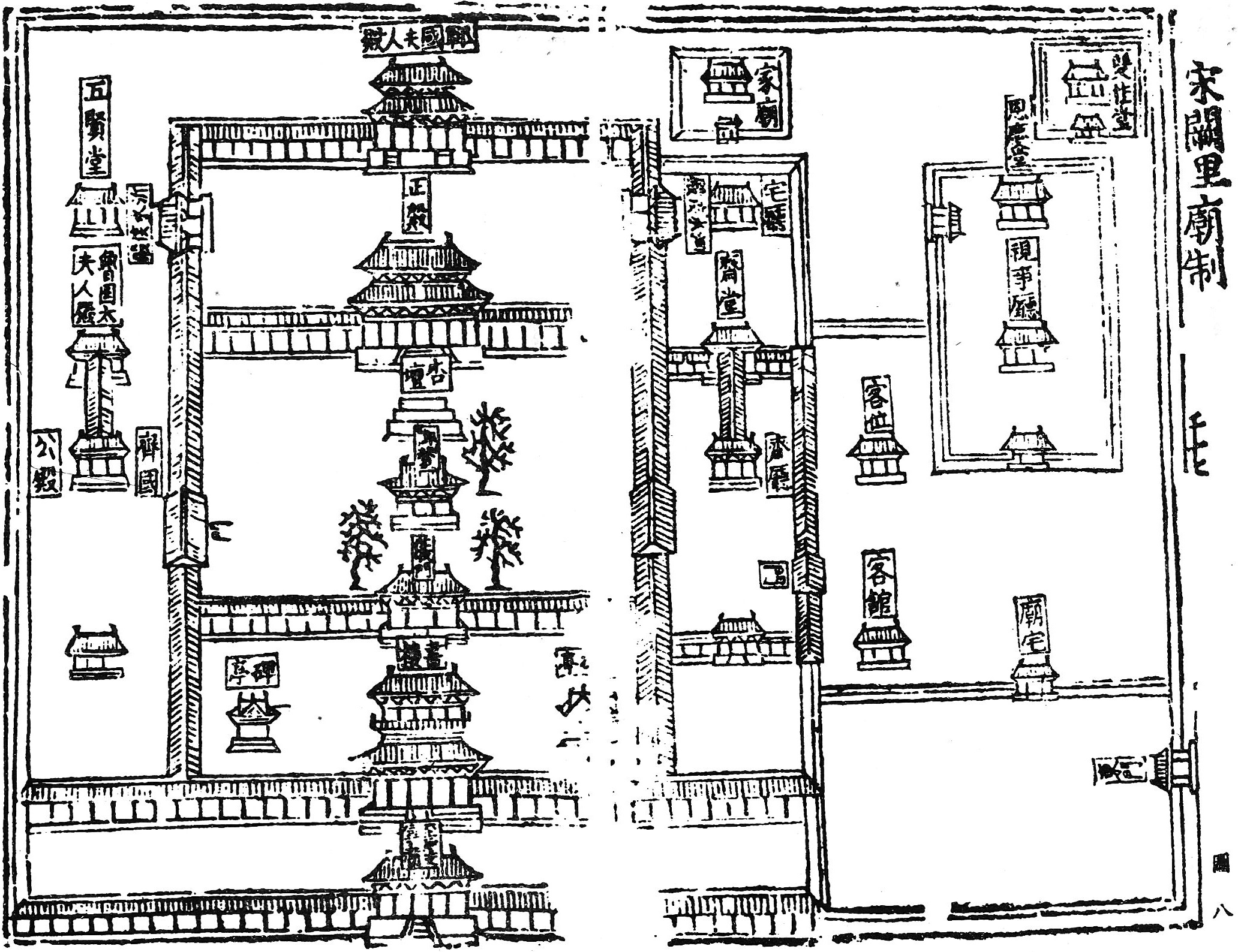 |
|
Drawing of the compound of the Confucius Temple (left) and the mansion of the Kong family (right) in Qufu during the Jin period 金 (1115-1234). From Kong 1227: 43. |
|
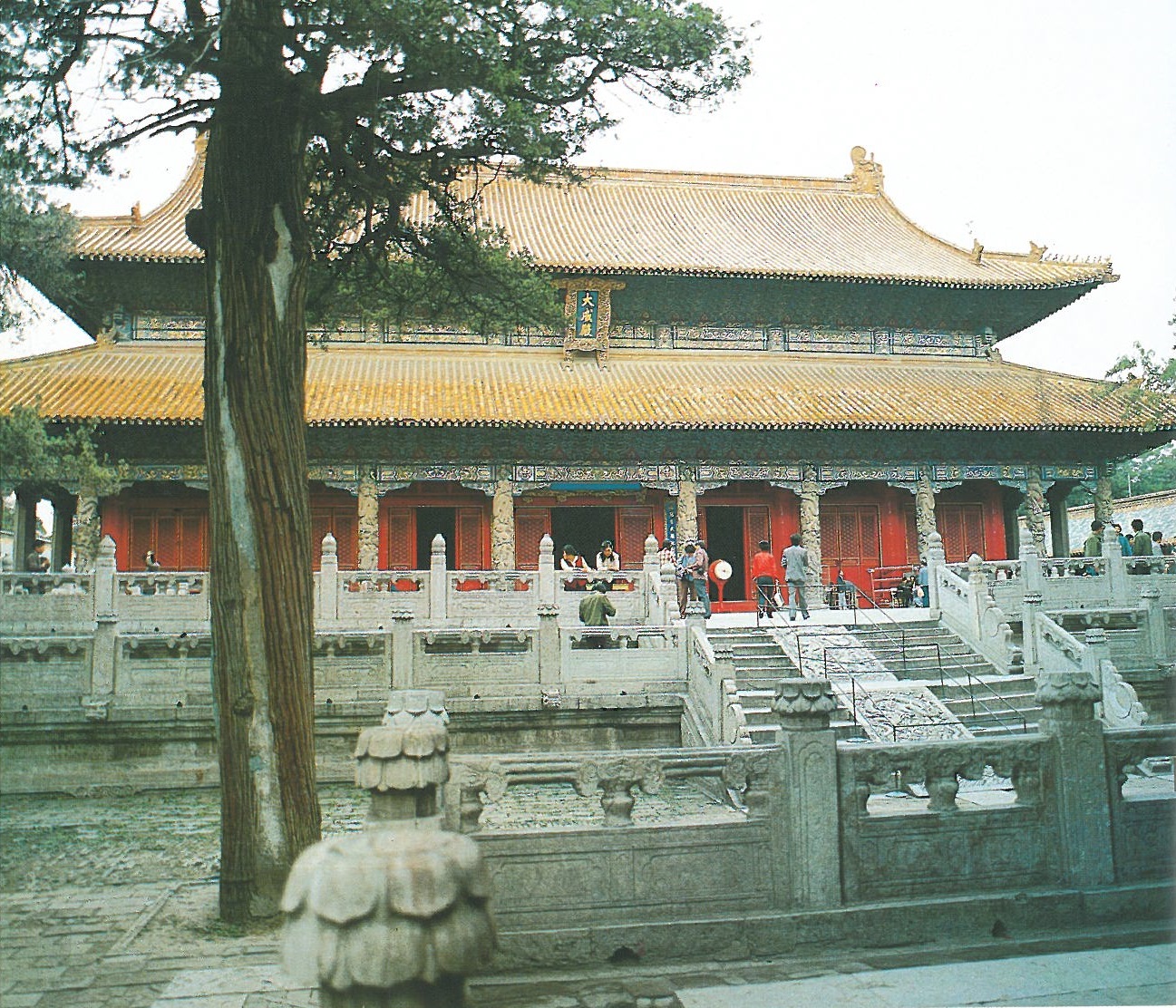 |
|
The central Hall of Completion of the Confucius Temple in Qufu. From Shandong sheng 1990: 41. |
|
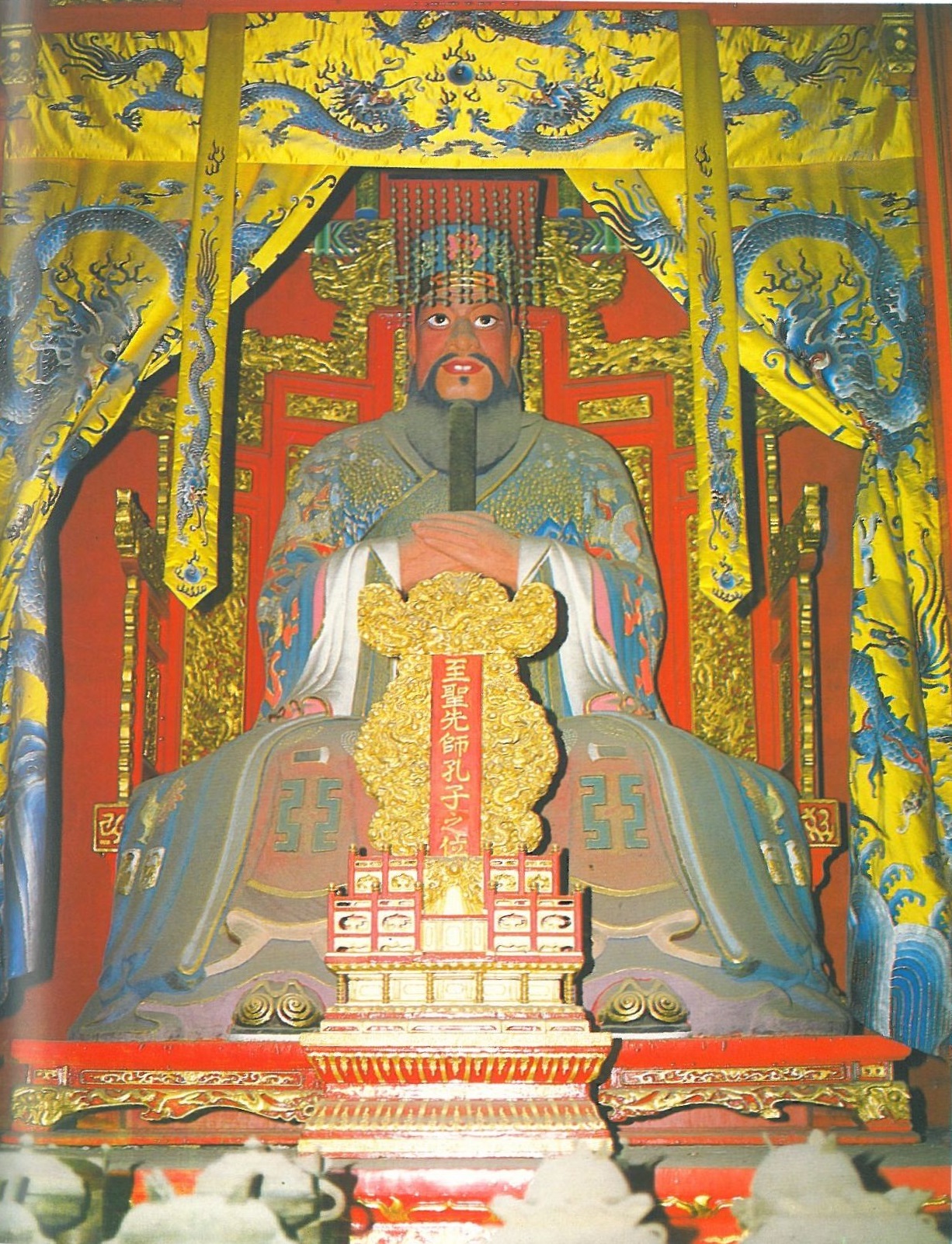 |
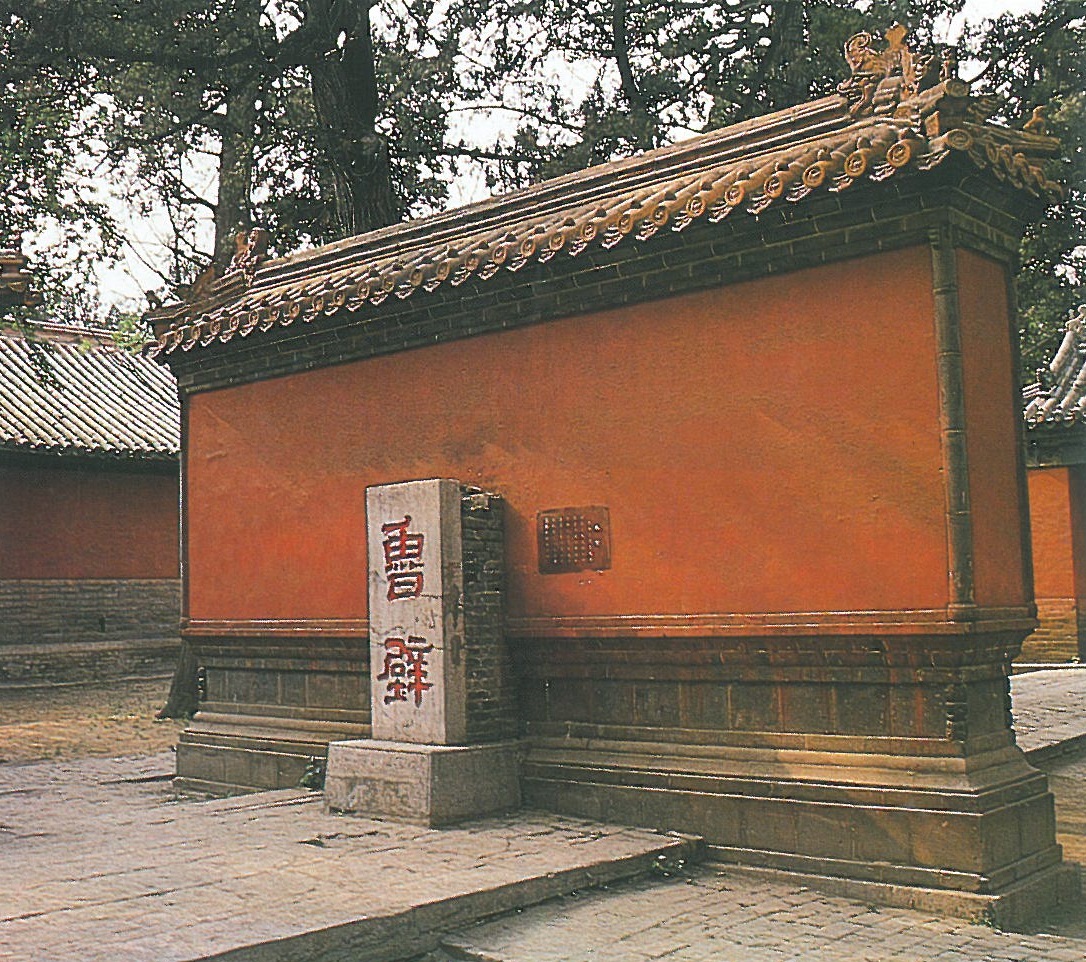 |
Left: Statue of Confucius in the Central Hall. Right: (Symbolic) Wall of Lu (Lubi 魯壁), where ancient old-text versions of the Classics survived hidden insided during the Qin period 秦 (221-206 BCE). From Shandong sheng 1990: 44, 66. |
|
The whole complex includes no less than 466 rooms and 54 gates and archways (menfang 門坊) and has a length of 652 m (north-south) and an area of 95,000 square meters. The areal is encircled by a wall with four towers at the edges (jiaolou 角樓). It is covered by a pines arranged in irregular manner to give the impression of a grove.
The buildings are decorated in a style used for imperial buildings, with yellow roofs and columns of carved stone, decorated with dragons and clouds (fudiao panlong shizhu 浮雕盤龍石柱). Some buildings house steles with inscriptions and stone or brick reliefs that were either dedicated to Confucius and his teaching or excavated in and around Qufu. The pieces of this "forest of steles" (beilin 碑林, Kongmiao beilin 孔廟碑林) are inscribed with texts of different nature (announcements in the ancestral temple yemiao 謁廟, sacrificial announcements jigao 祭告, reports on reconstructions of the temple xiumiao 修廟, tomb inscriptions muzhi 墓志, laudatory texts combined with paintings huazao 畫贊, poems and prose texts shiwen 詩文, or calligraphies of famous masters mingjia fatie 名家法帖) written in different writing styles (seal script zhuanshu 篆書, chancery script lishu 隸書, regular script zhenshu 真書, grass script caoshu 草書). The most famous among the more than 2,000 pieces are the inscribed steles called Yi Ying bei 乙鍈碑 (153 CE), Liqi bei 禮器碑 (156 CE), and Shi Chen bei 史晨碑 (169 CE), all dating from the Eastern Han period, and written in chancery script (lishu 隸書).
| 至聖先師孔子之位 | zhisheng xianshi Kongzi zhi wei | "Seat of [the Spirit of] Confucius, the Supreme Sage and Primordial Teacher" |
| 斯文在兹 | si wen zai zi | "That Cultivation [Created by the Ancient Sages] is Here [in Confucius]" |
| 萬世師表 | wan shi shi biao | "A Model of a Teacher for Ten Thousand Generations" |
| 化成悠久 | hua cheng you jiu | "The Completion of Cultivation Lasts Eternally" |
| 與天地參 | yu tian di san | "In Threefold [Unison] with Heaven and Earth" |
The Dacheng Hall is the central place of veneration. In its centre, a horizontal tablet is attached saying "Supreme Sage and Primordial Teacher" (Zhisheng xianshi 至聖先師). A statue of Confucius, symbolizing the seat of his spirit, is placed inside a so-called "spirit niche" (shenkan 神龕). The statue of the master is "accompanied" by four statues (si pei 四配) of his most important disciples Yan Hui 顏回 (Yan Yuan), Zeng Shen 曾參, Kong Ji 孔伋 (a grandson of Confucius), and Meng Ke 孟軻 (who was actually born after Confucius' death).
The two flanks of the Hall are inhabited by the statues of twelve further "wise" disciples (shi'er zhe 十二哲), namely Zijian 子騫, Zhonggong 仲弓, Zigong 子貢, Zilu 子路, Zixia 子夏, Youruo 有若, Ran Geng 冉耕, Zai Yu 宰予, Ran Qiu 冉求, Ziyou 子游, Zizhang 子張, and one of the Song-period master of Neo-Confucianism, Zhu Xi 朱熹 (1130-1200).
The Confucius Temple in Qufu was an important place of religious activities through the ages. Many emperors of all dynasties visited the shrine and paid reverence to the master of "Confucian" thought. Even the rulers of non-Chinese dynasties like the Jurchens, Mongols or Manchus, and the Japanese invaders venerated Confucius.
The temple was once occupied during the Ming period in the early 16th century, when a peasant rebellion swept over Shandong and destroyed books and used some buildings as stables. During the Cultural Revolution, Red-Guard students destroyed the statues and desecrated the ground, particularly in the early 1970s, when the campaign of "criticize Confucius and Lin Biao" (pi Lin pi Kong 批林批孔) was launched.
In the 1980s the Confucius Foundation (Kongzi Jijin Hui 孔子基金會) refurbished the temples, also with the support of overseas Chinese. Apart from restoring the original appearance, the ceremonies for the veneration of Confucius were revived.